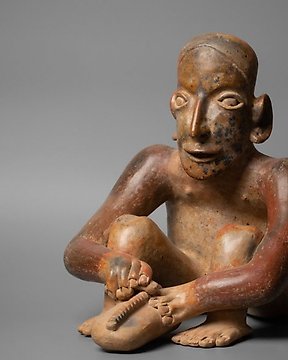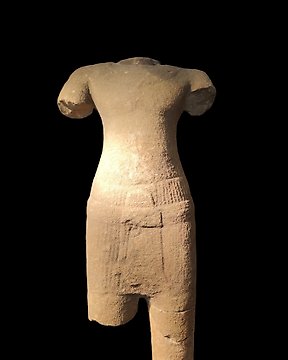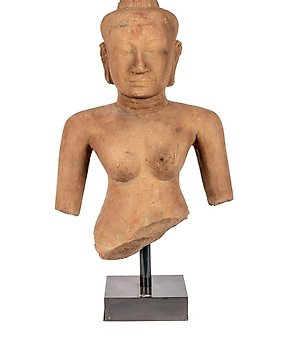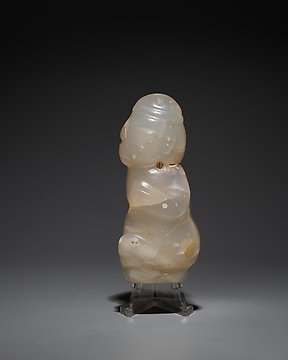Wunderbares Stück. Alles wie beschrieben. Hervorragender Kontakt.
Übersetzung ansehenNicoya-Guanacaste, Costa Rica Vulkangestein Stele mit zwei Rindern und Gesichtern. 800-1200 n. Chr. 100 cm H. Spanische Importlizenz.
Nr. 84916257

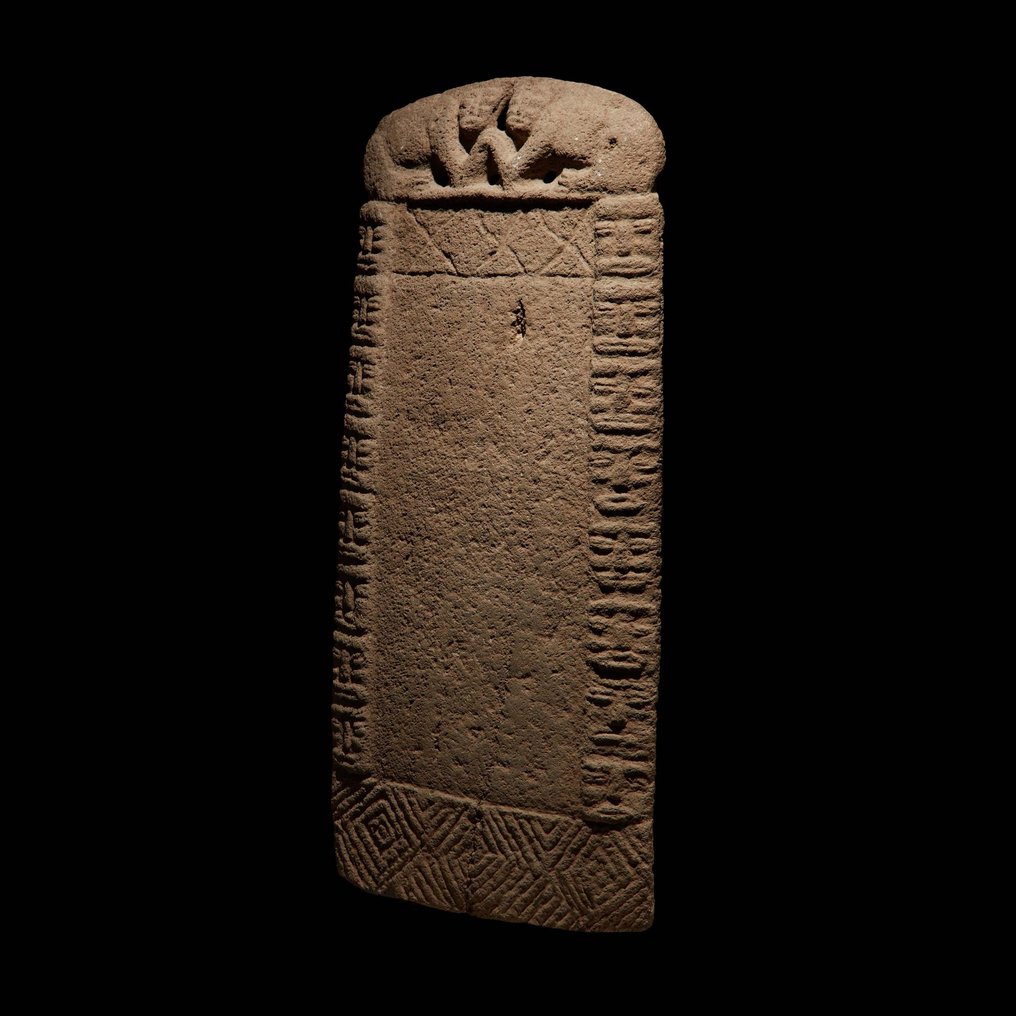
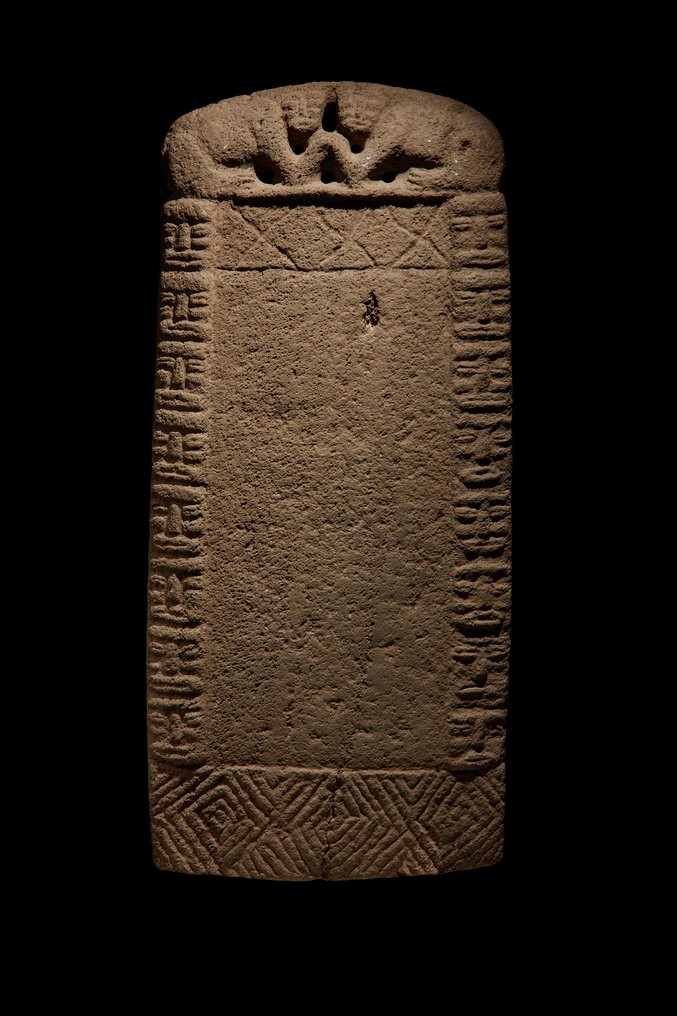
STELA OR CEREMONIAL METATE WITH TWO BOVIDS AND HUMAN HEADS
Nicoya-Guanacaste, Costa Rica, 800-1200 AD.
Volcanic Stone.
100 cm height and 43 cm length.
PROVENANCE: Private collection, Paris, France, 1970.
CONDITION: Good state of conservation, without restorations.
DESCRIPTION:
Piece in the shape of a rectangular plate, with a slight concavity in its central area, carved in volcanic stone with reliefs on its front and smooth back. The finish, in the form of a curved pediment, is composed of the relief figures of two confronting bovids on an openwork background. The animals appear joined by their front legs, the rear legs resting on the ground, with the body in profile and the face turned towards the viewer. Under the pediment there is a wide band with three incised blades. The profiles of the long sides of the piece are carved in relief with trophy heads placed on top of each other. The lower finish of the piece takes the form of a wide border, worked with incised lines composing a geometric design of parallel concentric lines, which fill the entire space. The central surface of the stele is completely smooth, empty of ornamentation.
The faces of the trophy heads and animals are carved in the same style, based on parallel horizontal bands, highlighted in relief: forehead, eyes, cheekbones and mouth. In the center, as a vertical axis, a wide and thick nose. The eyes and mouth are elongated, worked as horizontal bulges with a central slit.
The elongated rectangular shape and the absence of decoration in the large central space indicate that the piece could be a stele, or a metate for ceremonial use. In the case of the first option, the central surface would probably be painted. To date, the exact function of the Costa Rican stelae is not known, mainly due to the few examples found, although the appearance of some in funerary contexts (fig. 1) suggests that one of their uses could have been to indicate the presence of the tomb of an important person. In that case, the animal motifs would have alluded to the clan of the deceased.
If it were a metate or hand mill, it would in any case be a piece not for use but of a ritual or ceremonial nature, given that it reaches a meter in length, lacks legs and would not be very resistant due to the thin thickness of the stone. In the Guanacaste-Nicoya culture, ceremonial metates carved in volcanic stone were common (fig. 2), decorated with relief and openwork motifs that would allude to their owner or their religious function, and would probably be related to propitiatory fertility ceremonies. of the fields, since the metate was an object used in daily life to grind corn, a staple food of the area.
Greater Nicoya is an archaeological region that covers northwest Costa Rica and the Pacific coast of Nicaragua. The Southern Subregion, or Guanacaste, occupies the Nicoya peninsula, the Tempisque River basin and the Guanacaste and Tilarán mountain ranges. This is an area with human occupation for about 10,000 years, and important remains of material culture in ceramics, carved stone and jade have already been found in the Tempisque period (500 BC - 300 AD). In the Bagaces period (300 - 800 AD) there was already a complex social organization that was reflected in a greater variety in burial formulas, which included the use of large stone blocks. Around the year 800, the territory of Guanacaste was occupied by Chorotega groups from the north, from the Valley of Mexico, who were fleeing Olmec domination. This migration will bring the cultural influence of the Mayans and form the germ of the Kingdom of Nicoya, one of the main pre-Columbian chiefdoms existing in Mesoamerica upon the arrival of the Spanish.
Notes:
- The piece includes authenticity certificate.
- The piece includes Spanish Export License.
- The seller guarantees that he acquired this piece according to all national and international laws related to the ownership of cultural property. Provenance statement seen by Catawiki.
Der Verkäufer stellt sich vor
STELA OR CEREMONIAL METATE WITH TWO BOVIDS AND HUMAN HEADS
Nicoya-Guanacaste, Costa Rica, 800-1200 AD.
Volcanic Stone.
100 cm height and 43 cm length.
PROVENANCE: Private collection, Paris, France, 1970.
CONDITION: Good state of conservation, without restorations.
DESCRIPTION:
Piece in the shape of a rectangular plate, with a slight concavity in its central area, carved in volcanic stone with reliefs on its front and smooth back. The finish, in the form of a curved pediment, is composed of the relief figures of two confronting bovids on an openwork background. The animals appear joined by their front legs, the rear legs resting on the ground, with the body in profile and the face turned towards the viewer. Under the pediment there is a wide band with three incised blades. The profiles of the long sides of the piece are carved in relief with trophy heads placed on top of each other. The lower finish of the piece takes the form of a wide border, worked with incised lines composing a geometric design of parallel concentric lines, which fill the entire space. The central surface of the stele is completely smooth, empty of ornamentation.
The faces of the trophy heads and animals are carved in the same style, based on parallel horizontal bands, highlighted in relief: forehead, eyes, cheekbones and mouth. In the center, as a vertical axis, a wide and thick nose. The eyes and mouth are elongated, worked as horizontal bulges with a central slit.
The elongated rectangular shape and the absence of decoration in the large central space indicate that the piece could be a stele, or a metate for ceremonial use. In the case of the first option, the central surface would probably be painted. To date, the exact function of the Costa Rican stelae is not known, mainly due to the few examples found, although the appearance of some in funerary contexts (fig. 1) suggests that one of their uses could have been to indicate the presence of the tomb of an important person. In that case, the animal motifs would have alluded to the clan of the deceased.
If it were a metate or hand mill, it would in any case be a piece not for use but of a ritual or ceremonial nature, given that it reaches a meter in length, lacks legs and would not be very resistant due to the thin thickness of the stone. In the Guanacaste-Nicoya culture, ceremonial metates carved in volcanic stone were common (fig. 2), decorated with relief and openwork motifs that would allude to their owner or their religious function, and would probably be related to propitiatory fertility ceremonies. of the fields, since the metate was an object used in daily life to grind corn, a staple food of the area.
Greater Nicoya is an archaeological region that covers northwest Costa Rica and the Pacific coast of Nicaragua. The Southern Subregion, or Guanacaste, occupies the Nicoya peninsula, the Tempisque River basin and the Guanacaste and Tilarán mountain ranges. This is an area with human occupation for about 10,000 years, and important remains of material culture in ceramics, carved stone and jade have already been found in the Tempisque period (500 BC - 300 AD). In the Bagaces period (300 - 800 AD) there was already a complex social organization that was reflected in a greater variety in burial formulas, which included the use of large stone blocks. Around the year 800, the territory of Guanacaste was occupied by Chorotega groups from the north, from the Valley of Mexico, who were fleeing Olmec domination. This migration will bring the cultural influence of the Mayans and form the germ of the Kingdom of Nicoya, one of the main pre-Columbian chiefdoms existing in Mesoamerica upon the arrival of the Spanish.
Notes:
- The piece includes authenticity certificate.
- The piece includes Spanish Export License.
- The seller guarantees that he acquired this piece according to all national and international laws related to the ownership of cultural property. Provenance statement seen by Catawiki.
Der Verkäufer stellt sich vor
- 752
- 7
- 0
Extremely rapid courrier service from Barcelona to Flanders, picture was nicely and carefully packaged. Muchas gracias!
Übersetzung ansehenVery fine specimen! Thanks.
Übersetzung ansehengoede foto's, goede omschrijving, goed verpakt en snel verzonden.
Übersetzung ansehenmolto bello tutto ok
Übersetzung ansehenPezzo come da descrizione, davvero notevole. Venditore molto consigliato in quanto gentile e disponibile. spedizione molto veloce. Ottimo!
Übersetzung ansehenVenditore davvero ottimo e gentile. Merce come da descrizione, spedizione veloce. Ottimo l'avere certificato di autenticità.
Übersetzung ansehenUn 100 como empresa un 100 como envío . Empresa muy especial con mucha exquisitez en todos los productos y en personal . Muchas gracias
Übersetzung ansehenAll well! Thanks.
Übersetzung ansehenVery nice and fine cut little jewel! Well packed too! Thanks!
Übersetzung ansehennice piece and very fast shipping!
Übersetzung ansehenEs una maravilla de moneda, donde se le nota los pasos de los años y me encanta. Servido muy rápido y bien empaquetado. Con su certificación. Qué más se puede pedir?
Übersetzung ansehenSnelle en correcte levering, alleen was de verpakking voor het schilderij niet stevig genoeg.
Übersetzung ansehenHerzlichen Dank!
Übersetzung ansehenAll OK and with very fast shipping.
Übersetzung ansehenPrachtig schilderij. Zo blij mee. Zeer nette verkoper en zeer snelle levering.
Übersetzung ansehenperfect ! very fast and high quality delivery !
Übersetzung ansehenAll well! Thanks.
Übersetzung ansehenVendeur très professionnel, top +++×
Übersetzung ansehenPhotos trop contrastées pour bien percevoir les défauts, mais ces défauts étaient visibles pour autant. Le "Bon état" est trompeur. Sinon, envoi rapide et correctement emballé. Frais de port exagérés.
Übersetzung ansehenGreat communication, delivery and product. Came with a well made certificate of authenticity and good packaging. Overall very happy with the purchase! Delivery is a bit expensive, but I recommend it
Übersetzung ansehenMagnifique témoin du passé, envoyé avec tous les justificatifs, impeccable. Encore une fois très satisfait, un grand merci
Übersetzung ansehenThank you for the Special offer and the fast shipping of this excellent piece of art!
Übersetzung ansehenvery good description of the object, very good price for this rare item,. Fast sending (has been at my place 2 days after buying!). Definitely would buy again.
Übersetzung ansehen- 752
- 7
- 0
Wunderbares Stück. Alles wie beschrieben. Hervorragender Kontakt.
Übersetzung ansehen


